A Quilty Adventure Part II: How to Sew with Double Gauze
The next stop in our Quilty Adventure is a good one: Double Gauze. (Check out Part I: Denim, if you missed it!)
Double Gauze is the destination you see on a billboard while you’re driving down the highway and you’re like “STOP EVERYTHING WE’RE GOING.” It’s super intriguing, right?
I’m with you. But you’re going to want to come prepared. Browse this roadmap to double gauze sewing before you speed into your first project. You’ll be glad you did.
Welcome to Double Gauze!
Population: Everyone who loves soft, cozy things.
Read More From Our Quilty Adventures!
How to Sew with Double Gauze: The History
Even though sewing, and quilting, with double gauze is a more recent trend, gauze has been around for. Ever. The name comes from Gaza, in Palestine, which was the center of weaving in the region. Originally, gauze was made of silk, and used for clothing. Now, a lot of people associate it with medical gauze, which is made of cotton, and used for dressing wounds and burns.
Trending patterns!
Because gauze has an open, loose weave it’s perfect for healing. You know what else it’s perfect for? Doubling up for quilting.
Special Attractions
Quilting with double gauze is kind of like wrestling a cloud. The end result will be worth it, but expect this fabric to flow and move in ways your regular quilting cotton doesn't. Since this may be your first time on a Care Bear sewing adventure, let me tell you the best way to get from here to cozy quilt heaven.
Double gauze is pretty transparent, and known for its open weave. It is exactly what it sound like: two layers of gauze put together, which leaves it a little thicker than your typical quilting cotton, but still airy and breathable. I want to compare it to another fabric you may be more familiar with, but double gauze is very unique. If you want to know what you're getting into, walk to your first aid kit, open up a roll of gauze, then double it up. This sounds both obvious and crazy, but it really does feel like that. And yes, we can sew with it.
One super special attraction to this fabric is that one of my favorite fabric designers, Nani Iro, prints most of her designs on double gauze! A dream printed on a dream!
How to Sew with Double Gauze: What to Pack
I know what just happened. You looked at some gorgeous designs and you’re already at your sewing table. But hold up. Make sure you’re fully prepared for this journey.
- First, you know you’re working with cotton, so you know you want to pre-wash on low heat with some mild detergent.
- Dry on low heat for 5-10 minutes, and then lay flat until that stuff it totally dry. Now you’re in business.
- Before you even cut your double gauze, get out the spray starch (see this blog post for more on starch). Double gauze cuts best when it’s slightly stiff and wrinkle-free, so feel free to press it, too, if that’s something you do (but take care NOT to move your iron forcefully in circles. This stuff stretches and warps. Press means press, people.)
- As far as gear goes, don’t stress too much. Standard needles work fine for double gauze, but use a new one if you’ve got one. If you do have a fine sewing needle (maybe size 80) this would be ideal. But the most important thing is that it’s super sharp.
- Threadwise, 50wt thread works best for double gauze, working well with it’s lightweight little self.
Now that you have your shiz together, we’re ready to roll...
The Itinerary
Let the double gauze quilty adventure begin! Here’s what’s on the schedge:
- Use a longer stitch than normal. This doesn’t matter quite as much as when you’re working with denim, for example, but double gauze is a completely different animal.
- Do your best to avoid ripping stitches. Duh. I know. But double gauze isn’t very forgiving with the whole stitch rip situation. It won’t be the end of the world, and your project won’t be destroyed, but this is one of those times that you want to really measure and mark before you start.
- Seriously consider serging. If you have a serger available, serging the edges of a double gauze quilt makes it an absolute breeze to bind.
- Lift up the pressure on your patchwork foot. This will help your foot glide over the fabric better without pulling. Another option is to strap on your walking foot.
Meet Some of the Locals
Below are some beautiful examples of Double Gauze in all it's gauzy glory...
Iceberg, Felice Regina
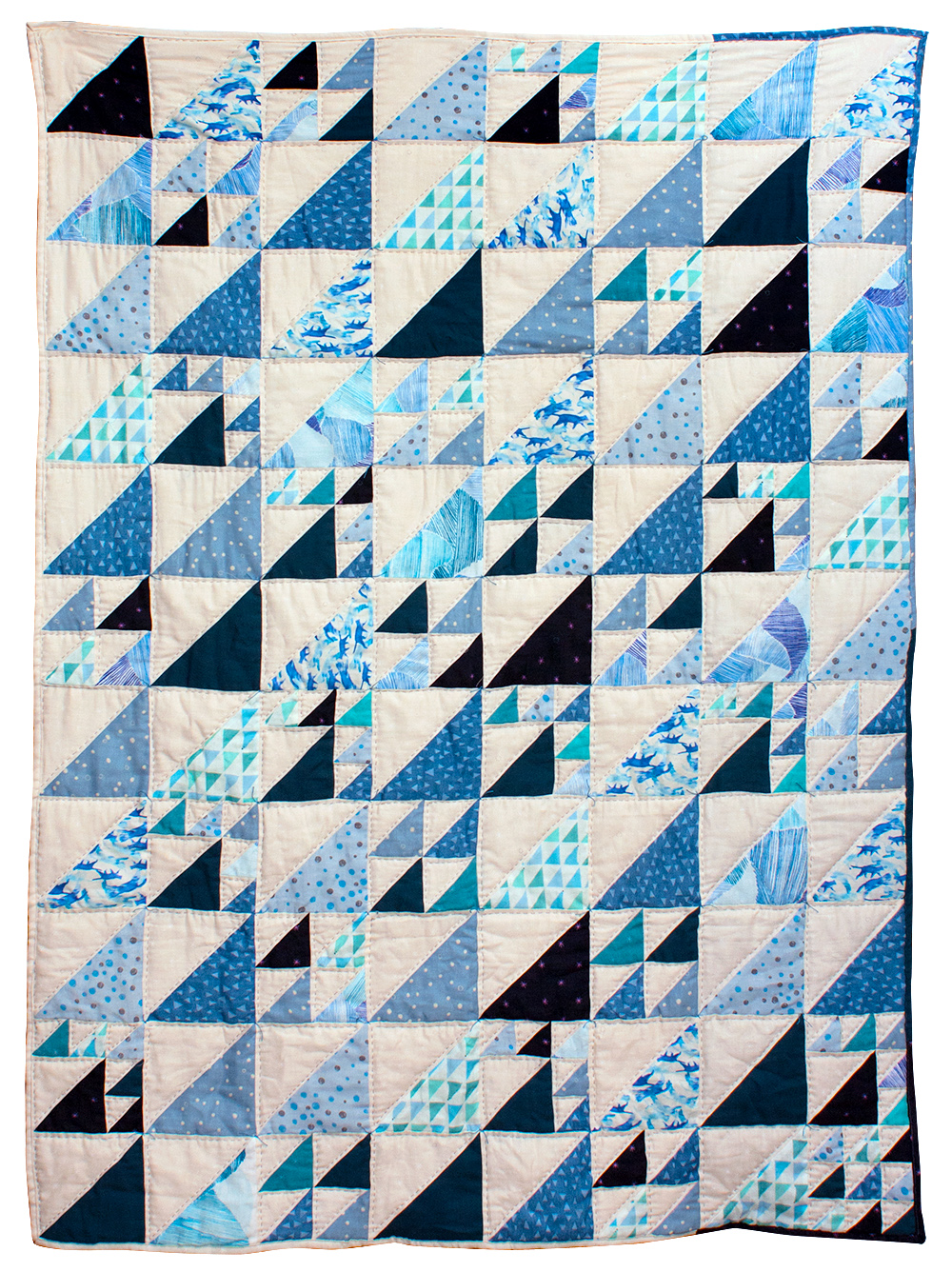
I want to reach into my computer screen, grab this quilt, wrap it around me and build a fort-for-one (and that one is moi). Not only is it made from extra cuddly double gauze, but is also tied with cotton thread and hand quilted. sigh....
My heart beats for you, Iceberg quilt...I'm in love.
Hand-Stitched Whole Cloth Double Gauze Quilt, Leigh Laurel Studios
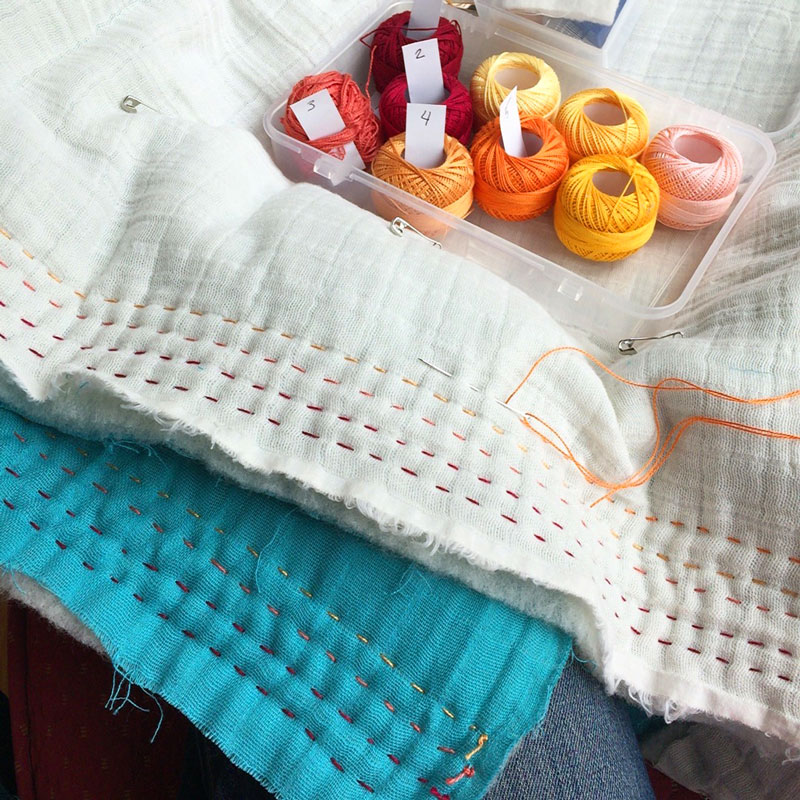
In multiple blog posts I have mentioned my slow evolution from exclusively using longarm quilters to learning about the speed of machine quilting and then slowing back down and finding a love of hand quilting (here, here and a list of my supplies here).
Oh my gosh, THIS. Guys, THIS! THIS double gauze whole cloth quilt is going to be my Christmas holiday project. Picture yourself visiting the in-laws for a week with NO ACCESS to a sewing machine. What is a quilter to do??
THIS. Sit by the fire/the TV/the kitchen table anywhere and stitch, stitch, stitch away with the yummiest, creamiest, most cuddliest materials around.
Pure + Simple Quilted Blankets, Purl Soho
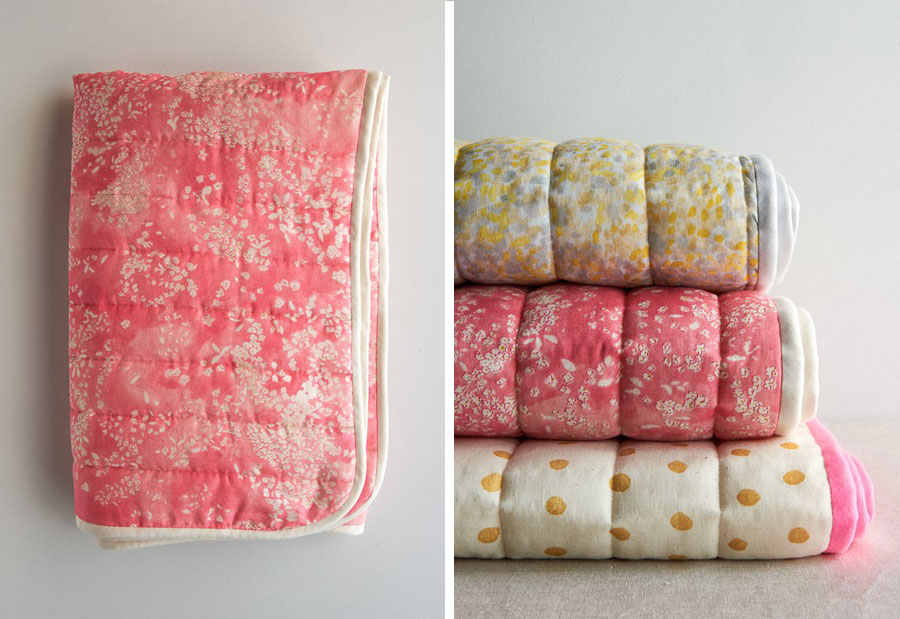
Want a FREE tutorial showing you how to make a very impressive quilted double gauze blanket in a couple hours? Sure you do 🙂
Before You Check Out
The land of double gauze quilting is a gorgeous one. Though double gauze may not seem excitingly novel or crazy different from what you have used before, the finished product is so, so good. In fact, I want to see yours. If you have a double gauze masterpiece you want to share with your fellow travelers, post a link to it below!
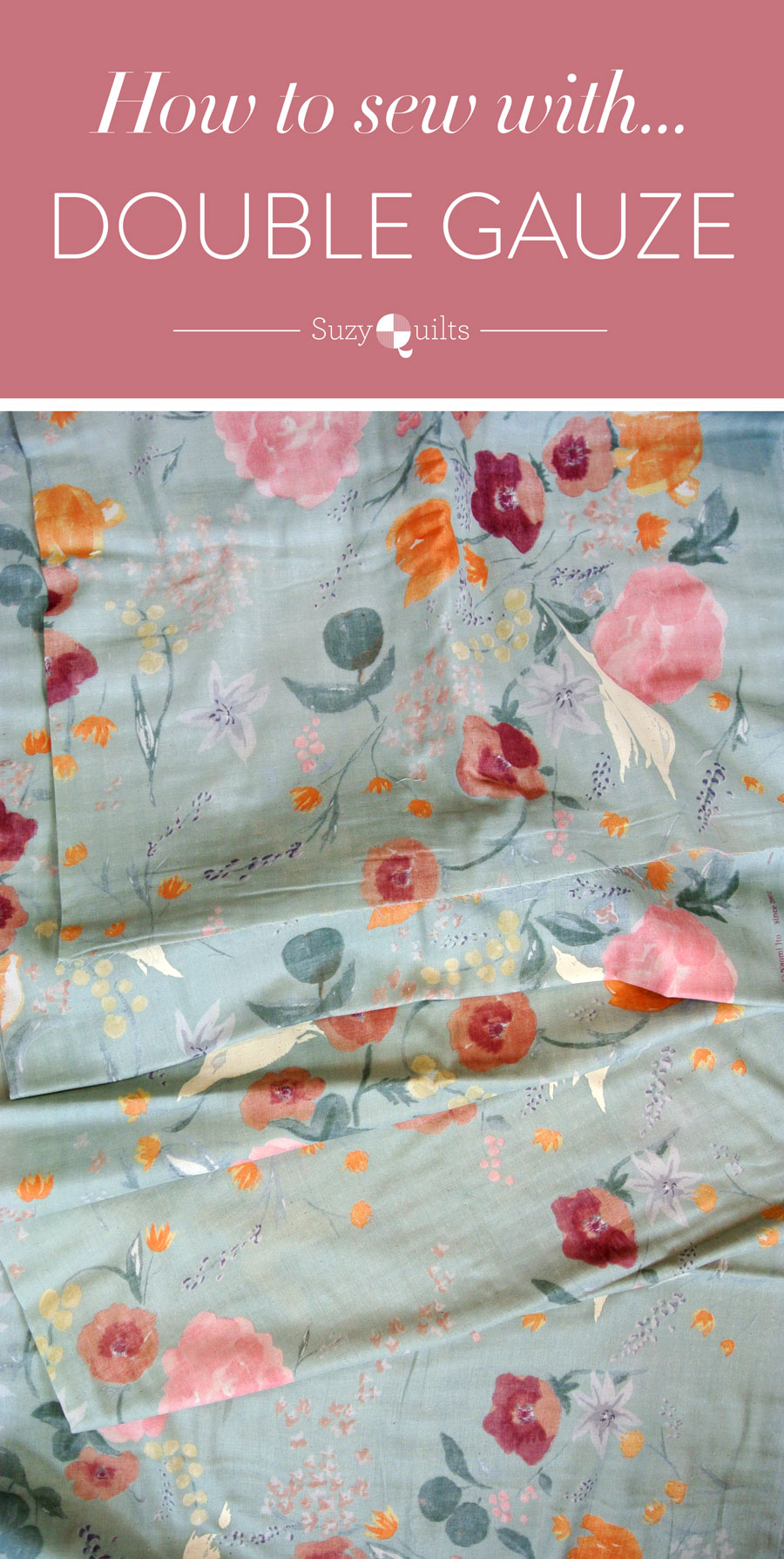
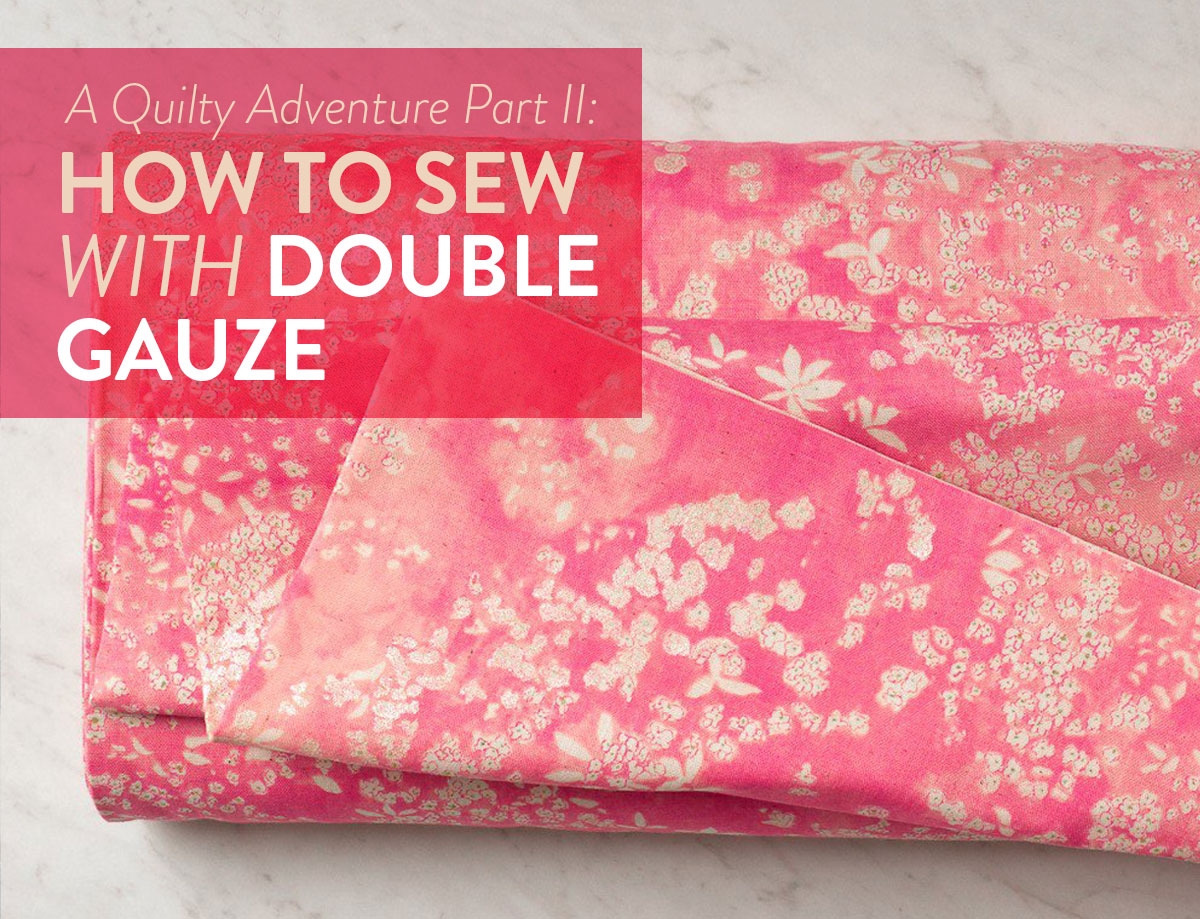
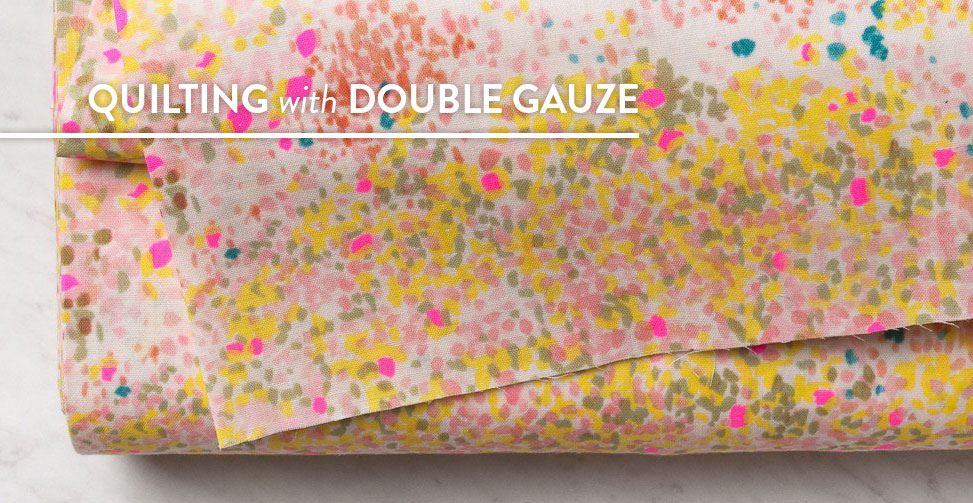
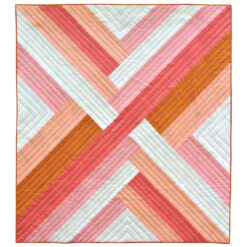
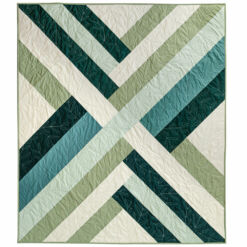
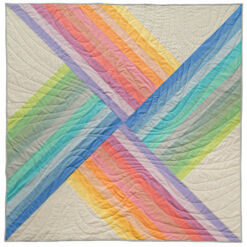
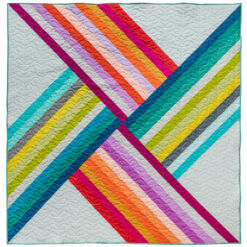
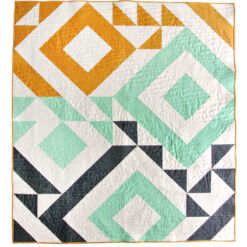
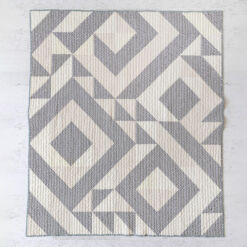
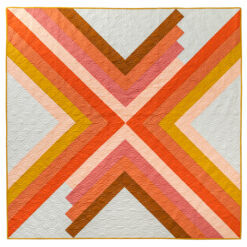
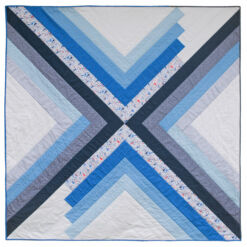
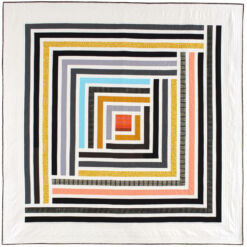
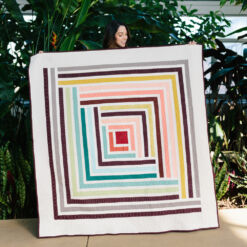
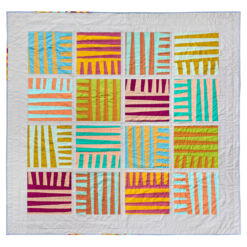
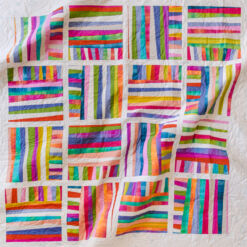
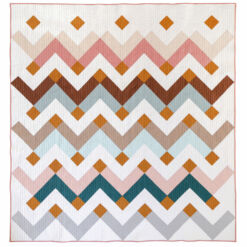
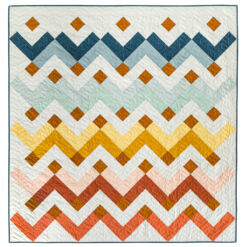
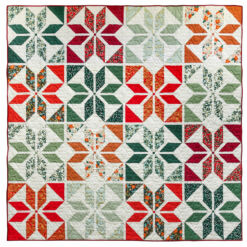
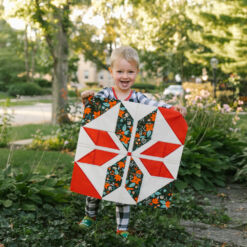
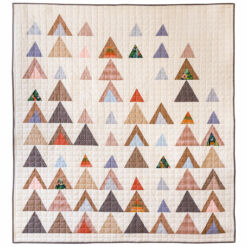
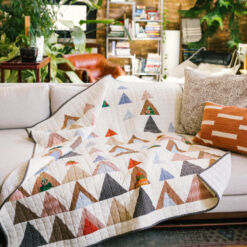

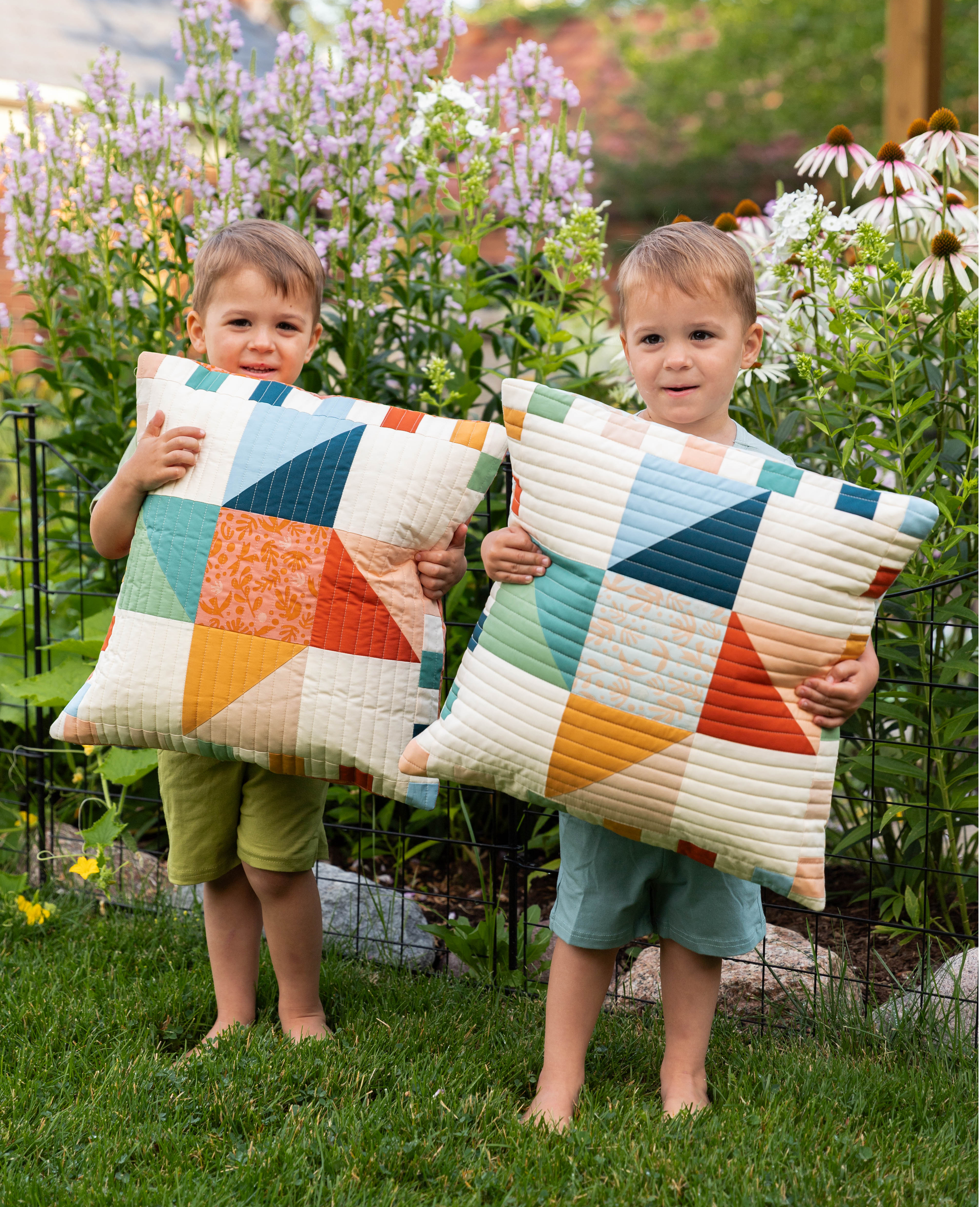

Do you have to zigzag the edges before you throw the yardage in the washing machine to prevent the layers from separating?
That would definitely save inches of fabric from fraying, but it’s not necessary. Now that I think about it, a simple basting stitch around the edges would be enough to prevent the double gauze from fraying. If you wanted to test it yourself, you could cut 5″ squares and try stitching around the edges of one and not on the other. If you do that, be sure to report back with your findings! 🙂
I am making my first double gauze quilt (whole cloth, double gauze front and back and cotton batting), and I’m planning on binding with double gauze, as well…. BUT I was also thinking of rounding the corners. I usually straight grain bind (gasp!) instead of making bias tape unless I’m rounding corners instead of mitering. Does the double gauze have enough give to go around the rounded corners if I cut straight grain binding? Or do I just suck it up and stop being lazy? Or will I wanna die as I try to work with a double gauze bias edge??? Help!
hmmmm…this is a great question and I’ll have to give you my best answer based on theory rather than practice. Double gauze is a tricky thing, especially when dealing with smaller strips of the stuff (ie. binding) because it can kinda fall apart on you. Not so much unravel, but the layers can separate. And sine it’s cotton, it’s about as stretchy as you would expect cotton to be. So, I think that you should treat it as you would treat regular quilting cotton. If you want those sweetly rounded corners, cut it on the bias. I know that’s not what you wanted to hear! Sorry!
This fabric has had me curious, but I couldn’t get past “baby blankie”. Thanks for the explanation and tips, I can see more possibilities for this fabric now ☺
Can’t wait to see what you make!
How do you mark your stitching lines on double gauze when hand stitching? Currently I am using masking tape and it is a pain to keep moving it! I watched one of your tutorials on the Heramarker – will that work on double gauze?
I think it will work on double gauze. The only thing to do is test it out. If you don’t have a hera marker handy, grab a butter knife from your kitchen and use the dull side. Report back with your findings!
Yay!!!!!!! I’m excited. Soon soft. I haven’t sewn with it yet so I’m ready to learn
Would double gauze make a “flowy” top or is it too thick or stiff to drape nicely?
It would, but I think Voile might be better if you want the “flowy” look!
I know it’s a bit late to comment on this, but I have a double gauze summer blanket in queen size. We use a lot of this type in summer but it drapes a lot more than regular cotton fabric even though it has a bit of loft as the fabric is already quilted. I live in Japan and we have single gauze, double gauze (summertime favorite), triple gauze (spring appropriate), and so on up to seven layer ones I’ve seen. Seven layer gauze I’ve felt is sold as home decor fabric and thicker than Oxford cotton fabric and it’s quite more thicker than even canvas but it’s very soft and still drapes even though it’s much thicker and it was really pricey. For 1 yard it was $30-40, and it was made of organic cotton.
In Japan it’s been popular fabric for boiling hot summer in 90% humidity outside and 35c August weather. I’ve made three tiered skirts on its own and it flows really nicely. I just love it breath the best than others fabric.
The thing about double gauze is it gets softer and softer you wash it. Much more so than regular cotton fabric. But it won’t hold its shape as it’s really soft. I’m currently making nighty and camisole (lounge and sleepwear). It’s very nice and I think it’s the best fabric for summer.
My friend requested a quilt with a soft back, and I thought this might work well! But would you recommend using both quilting cotton and double gauze – cotton for front, gauze for back? Or do you think keeping them separate is a better idea? Also, do you bind with cotton or gauze? Thank you!
You can do either of those things. Binding with reg. cotton would be a bit easier because it stretches less, but a double gauze binding is a great cozy option too. Mix and match it up!
Do you have any tips on cutting on double gauze fabric? (As in strips, half square triangles, etc) prior to sewing squares?)
Well, since it does shift and warp a lot I would just keep that in mind when picking out a quilt pattern. Cutting really small pieces of double gauze (like anything smaller than 2″) will prove to be very frustrating. Also, on-grain cutting will be much easier than cutting triangles on the bias. If you want to do a half square triangle pattern, check out my shortcuts – you cut squares and then sew on the bias. This will help keep your fabric in line.
https://suzyquilts.com/half-square-triangles-tutorial/
I’m really stressing about using pre-made/purchased binding on my double gauze blanket I’m making. It is 50/50 polyester/cotton. I have pre-washed the double gauze fabric. If I iron/lightly starch before sewing to bind, won’t the 50/50 binding bunch up around the edges — because it won’t “shrink” — and make the blanket not lay flat-ish? Or end up being like a cone coffee filter? Or will the whole thing accommodate — because double gauze is stretchy — and be just fine? I’ll be taking deep breathes while awaiting anyone’s thoughts on this 🙂
Breathe in. Breath out. 😉 I think you’ll be fine since you pre-washed your double gauze and 99% of the shrinkage has already occurred. No coffee cones will be happening. haha. Good luck!
Hi! I’m wanting to make a Memorial blanket for my baby we just lost and a matching one for his living sister. I’m wanting to style it after a Little a unicorn quilts which is two layers double cotton. I’ve never bound anything. Tips? Tricks? I have a serger and an embroidery/sewing machine. I’d also like to embroider their names on them. Tips for that?
Hi Meagan, I’m so sorry for your loss. A memorial quilt is a wonderful idea. I have a tutorial video with written instructions on how to bind a quilt. Check it out – https://suzyquilts.com/how-to-sew-binding-on-a-quilt/
Thank you! So one more question. I am a total newbie sewer. Like Ive made an apron and rice packs…should I make bias tape out of the double gauze? Would that be hard? Can I use other bias tapes that aren’t the same fabric of the blanket? Would that be bad or weird? Also I want to embroider my babies names on them. Do I do that with interfacing? And I should do it before I assemble the blanket right? Sorry for all the questions! I only have until Aug 5 to get these done as that’s when my baby will be buried and I am not feeling like that’s enough time!
Do you recommend bating with a double gauze quilt and if so what kind? Also how do I work some applique on the quilt – any tricks or just business as usual?? Thanks!
You can use any regular batting. If you wanted to make it feel like even more of a dreamy cloud, try wool batting. Wowzer. That would be mega cuddly. Appliqué on double-gauze…hmmmm… I would definitely recommend using a fusible webbing so that your appliqué pieces are very secure before stitching them down. I really like the paper-backed Pellon Wonder-Under.
I have a baby quilt from just cotton fabric and was thinking of using the double gauze for the back. However I do not prewash my fabric so am concerned if I prewash the gauze the shrinking will be off. Hopefully that makes sense!
I would suggest pre-washing the double-gauze just because it can tend to shrink up a bit more than regular quilting cotton due to its loose weave. Don’t worry about uneven shrinkage. Once you quilt your three layers together and wash it, that baby quilt will be sooooo soft and yummy!
Hi! I have made a double gauze quilt out of beautiful Nani Iro fabrics, please have a look if you like https://instagram.com/p/BUnPkD5hcje/
Only my second ever quilt and first time sewing with double gauze. Spray starch is your friend 😊
Would this be too heavy for the bunting type wraps that are so common today? I have made a couple using the single gauze, but I have never seen the double gauze. Seems like it would be easier to sew. (I do not have a serger.)
No it would definitely not be too heavy. Double gauze is very soft and flowy.
Hi Suzy! Looking for super lightweight quilt options for Florida summer bedding… double gauze has me intrigued! Does “double” mean both the top and backing? Or are you doubling it as the top? What’s the most lightweight batting option? Or can we get away with no batting at all?
It’s called double gauze because it is literally two pieces of gauze on top of each other – you can actually separate them if you aren’t careful. I’ve heard of some quilters opting for a piece of jersey instead of batting. However, if you wanted a breathable, lightweight batting, I’d suggest trying bamboo. You can read more about that here – https://suzyquilts.com/how-to-choose-the-right-quilt-batting/
Hello, I’m having my first grand child expected date end of November. I’m wanting to use Heather ross kokka double gauze, HR kokka linen blends, and cotton/poplin together for the top. However due to the expensive of these items I certainly do not want to mess them up. So I’m practicing in advance. Any advice for using these three together I should be aware of? Most are prewashed but not all the gauze is all Prewashed. Thank you for any advice
What a pretty combination of fabric! I recently did a similar combo when making this baby quilt. I personally think mixing different types of fabric gives the quilt so much more dimension and texture! Since you have prewashed most of your fabric, I recommend starching all of it before cutting and sewing. You can also use starch again when ironing your seams. One tool I like to use, especially when mixing fabrics, is a tailor’s clapper. You can see a short video on how I use it here.
Hello.. I looked at the pattern from Purl Soho that appears to say that the fabric is pre quilted. The pattern says that it only needs binding. No batting,, no quilting.
I cant see the fabrics here are already quilted
Can you help me make sense of it please
What you would buy, in a sense, is the the quilt and then you would trim it down and add binding. The fabric is already quilted on the bolt.
Hi! These are so yummy! I’m planning on making a quilt similar to the Leigh Laurel Studios quilt you featured. I’ve prewashed my fabrics but am wondering about if the DMC floss needs to be prewashed/shrunk? Worried that the thread will shrink in later washings and cause problems. Advice? Thank you!
Your thread and batting will both shrink a little bit after washing, but if you prewash your fabric and use prewashed batting, it won’t be a drastic shrinkage.
Would you recommend prewashing the batting if using prewashed double gauze? I still want the crinkle…but don’t want to wreck it!
Most store-bought batting comes prewashed, so I doubt you would need to do that. If the batting specifically says that it’s not prewashed, hopefully the packaging has instructions on how to do that. I wouldn’t want you to end up with a big tangled batting ball. 😉
Hi Suzy. I was set to use wool batting with some double gauze, but have read some people have found it becomes itchy and/or pills after some use. Have you had this problem? If so, what other batting would you suggest? Also, do you use cold water gentle wash and low heat dryer for care? Thanks!
I have never had a problem with wool batting. It’s possible those people used a wool blend? Or maybe a brand that wasn’t processed well? I absolutely LOVE Quilters Dream Wool. As for quilt care, I have a few articles on that 😉 https://suzyquilts.com/wash-and-care-for-a-quilt/ and https://suzyquilts.com/how-to-care-for-your-new-quilt/
Yeah, I canʻt figure it out. Maybe Iʻll take the gamble. 🙂 Thank you so much!
Hi Suzy! Does double gauze pucker up when you wash it? Like muslin baby cloth. Thanks
It does! It puckers up exactly like a muslin baby cloth, so prewashing is a good idea.
Hi Suzy,
After reading your recent post about making the softest quilts for the twins, well I was quite touched and also freely shed tears. Then last Saturday I happened upon some very pretty double gauze in one of my favorite quilt shops, yes ever so soft! So of course a baby quilt is planned – as I also found a very soft panel with forest animals including a hedgehog – the recipient is named Daisy, and her aunt, my friend loved the hedgehog fabric I used in another quilt. So obviously this quilt was meant to be…..
Now for my questions, should I pre-wash the double gauze? The same for the quilting cotton? I’ve had panels go so wonky after washing, but I can stitch the edges and go with it if that is what you recommend.
Also, I long arm, and while I’ll quilt this lightly to maintain the softness, I really do want to use the long arm as I’ll do a better job of quilting the animals in the panel – yes that little hedgie has some friends, all equally cute! Any suggestions for how to clamp the sides so I’m not stretching it?
Thank you for all of your help!!!
Lottie
Great questions! I recommend prewashing, but you don’t have to. Just be prepared for your quilt to crinkle up a lot after the first wash. I suggest basting your quilt sandwich like normal. I use pins, but with your machine you probably can’t do that. Since you will be longarming, some simple loops or any other loose stitching design would look great!
This is helpful! I have my double gauze fabric for both backing and front. I want to quilt it with swirls but with all double gauze quilts I’ve looked up, they have straight line quilting. Is it difficult to quilt it?
It’s not difficult to quilt, I just think it’s not a very common material in the quilt world. You should go for it!
Thanks for all your comments and advice. I’m making twin sized quilts and have a the front(top) picked out. It’s 100%cotton knit with a little stretch but not much. Would you recommend using double gauze for the back or would the different fabrics make it move too much? I assume I should prewash both? Thanks!
What a scrummy soft combination! I love it!! And yes, prewash both 🙂
Thanks so much for this post! I’m new to quilting and am about to start my second quilt (your fishing net pattern🤗) but plan on using double gauze and Essex linen. I’ve read that for double gauze I need a longer stitch length and for linen I need a shorter one. Will doing something in the middle be okay, or should I rethink my fabric choices? Thank you!
As much as I LOVE mixing different kinds of fabrics, double gauze and essex linen are two very different textures. Double gauze is incredibly fluid, light and transparent while Essex linen is exactly the opposite – stiff, a bit scratchy and much thicker. The good thing about Essex linen is that it’s a cotton/linen blend, so I recommend treating it like a basic quilting cotton. Definitely prewash both fabrics, but you can use a 2.5 – 3 stitch length when sewing with it – if sewing it to double gauze, use a 3 stitch length.
Did you catch the post about my double gauze Fishing Net bay quilt? Just double gauze is a wonderful option for a baby 🙂 – https://suzyquilts.com/how-to-make-the-softest-baby-quilt-in-the-world/
How about linen or linen/cotton on the front and double gauze on the back? I’m thinking a couple of quilts ahead, and I want to make something for a friend who tends to run hot. I sew by hand.
You could definitely mix the two, especially if one will be on the back and one on the front.
I ended up using mostly batiks for the top of her quilt, and 4 oz denim for the back. It came out very soft and drapey.
But I’m now making a quilt from a linen “scrap bag” I picked up for a fiver, and planning to back it with double gauze. No idea who this one will go to, I’m just playing with designs.
Mere,this combination of Essex Linen and double gauze as a backing is what I’m contemplating. Did you finish your quilt. I’m very interested in the outcome. Thanks!
Hi Vickie!
I’m so sorry I missed your reply. I did finish the quilt and it worked perfectly! Super happy with the outcome.
Where do you purchase your double gauze?
I mostly get it from fabricworm.com or fabric.com. This post includes links to my latest quilt and its fabric.
I just finished a blanket with DG + cotton batting + DG and cotton quilting fabric as binding. So now the next one, I’d like to use all DG and no batting just another plain white double gauze in between. Question is : do I always need to use a cotton or wool batting between my top and back double gauze?
Great question! I’ve always used batting in my double gauze quilts, so my response is purely speculative. with that said, double gauze is rather transparent, so if you choose not to use batting in the middle, which adds an opaque buffer between the top and the backing, your quilt has the potential to be incredibly light and also a bit transparent. That might be what you’re going for, but keep in mind that also means your seams will show.
Hi Susie,
I am new at working with double gauze fabrics. I am making a tie baby quilt, and I have a bubble gauze cotton fabric. Is that the same as a double gauze fabric, and would it hold up well if paired with a quilt cotton fabric on the front, and the Bubble gauze fabric on the back? Anything special in handling this fabric? Thank you so much. Sincerely, Leann
I believe “bubble” gauze is the same thing as double gauze, but just with a bit more texture. It will definitely hold up well paired with another cotton fabric. I have another article on working with double gauze if you want more tips – https://suzyquilts.com/how-to-make-the-softest-baby-quilt-in-the-world/
Hi Suzy! I appreciate all of the helpful information you’ve shared here. I’m working on a quilt for my son (cotton top) and want to use wool batting and double gauze for the back. The problem is that I hand quilt and can’t find much in hand quilting with double gauze. The practice sandwich’s I made frayed so much that I’m worried about using gauze without a serger. Any advice for hand quilting with gauze? I’ve considered a wider seam allowance and maybe double folding and hemming all the edges before quilting. I appreciate any advice you have!
Hi Karilea, first off this quilt sounds like it going to be a dream to cuddle! Double gauze, wool batting and hand quilting? Yummmm! If you are having trouble with fraying, I suggest sewing a basting stitch (something around a 5-7 in stitch length) around the edges of your quilt sandwich. That should stop it. Serging the edges would work too if you have a serger and would prefer that. If you want to avoid machines all together, hand quilt a basting stitch all around the edges. That would be just as effective. Good luck!
Hi there! Great article, advice and suggestions for quilting with double gauze.
However, what might you suggest when using double gauze to make a memory bear? Or other stuffed animal? Thanks!
Can double gauze be used for piecing regular quilt blocks? Thanks in advance.
Yes, however you may lose some accuracy because of its shifty nature.
Yep – right behind you in making a fort of this. Have had several nephews recently (they come in groups now!) and made a bunch of the double heaven blankets for them. Now am getting them back – for repairs. Seems the little buggers loved holes in them by rubbing them on their cheeks! (Just like their moms did years ago) I have had some luck with Fray Block®, still soft, little or no stain. Starching it also helps, helps from pulling the fabric while sewing then a final gentle rinse before gifting.
Hi Suzy, I am making a 60X90″ Gee’s Bend style strip quilt for my 25yo son and I’m looking for the most cuddliest- most inviting backing fabric. I’m considering using double gauze, but I have a few questions….1)is double gauze durable and can it withstand the test of time with a 25yo male?
2)do you think my project is too big to successfully be able to machine quilt the top using simple straight lines. I value your expertise and everything you post! Thanks!
If you’re doing the machine quilting yourself on a domestic machine, I’d skip the double gauze as backing for such a large quilt. It might get puckery and wavy. Have you thought about using flannel? That’s a very cozy fabric and much easier to use as backing. It’s more stable and will adhere to your basting better.
First of all, I *loved* this post. I definitely felt like I went on a journey, and you made my smile along the way. So thank you for that. Who doesn’t need a nice big smile in 2020?
Anyway, I am obsessed with Nani Iro as well. I have also become rather obsessed with sashiko! My question for you is, would you recommend using shashiko thread on a double gauze quilt top + quilters dream cotton batting (prewash not recommended) + quilt back?
Also, another question! I was taught not to prewash quilting cottons. Should I be pre-washing my cotton quilting fabrics? What about fat quarters?
Thank you so much!
Nicole
I think sashiko would be a beautiful addition to a double gauze quilt. My only caution would be to make sure your starting and finishing knots are large enough that they do not easily travel through the larger weave of the fabric. And yes, I recommend prewashing your fabric UNLESS you are using precuts like fat quarters. Don’t prewash those. You could end up losing too much of the fabric to shrinkage and fraying that you don’t have enough for the quilt pattern you’re trying to make. Here’s an article with more information on that – https://suzyquilts.com/should-you-prewash-fabric-before-quilting/
Did you use thread or floss for the hand quilting! If floss how many strands? Thanks in advance! Love your site and blogs!!
I use 8 wt. cotton thread. You can read more about my hand quilting here – https://suzyquilts.com/how-to-hand-quilt/
can I appliqué with a batik on double gauze? also I’m planning on quilting with sashiko stitches around some beautiful hearts on top gauze and the back is white gauze.
Technically, I don’t see why you couldn’t do that, but personally I wouldn’t. That would be like decorating a dessert topped with whipped cream by covering it with Jordan almonds. It might look good, but you would miss out on all of the light fluffiness of the cream because of the hardness of the almonds. Make sense?
if I use a double gauze with a print should it be doubled like it comes off of the bolt or do you unfold it to a single layer.
the print will show through if I do.
what do you suggest?
thank you!
Print or no print, do not unlayer double gauze. It is meant to be sewn as it comes off the bolt.
Hi! I was wondering, is 4-layer gauze similarly dreamy to work with? I’m finding very limited double gauze, but fabricworm had a lot of a 4 layer gauze and I know nothing!
I recently saw this 4-layer gauze too! I’m assuming it’s exactly like double gauze but thicker. So yes, sounds very very dreamy!
Hi Suzy! Big fan and I really appreciate the time you’ve already given answering my questions (I’m the same Meg who asked about 4 layer gauze). I’m working with double gauze for the first time. I just cut my first pieces of it and the edges are really delicate! I used a zigzag blade on my rotary cutter to help with fraying and made a grid with iron away pen on the tacking stitches in the fabric so I could make my cuts easily on for close to grain of fabric, but the layers are still really…er, floaty. I’m not sure how to handle it. I’m a hand-piecer and have no idea how to deal with it. Help? How do you keep it together during piecing?
To some degree you just have to go with the flow. And use a lot of pins and starch 😉
I love this series on how to quilt with different fabrics! There is double gauze in my future. I also love the metaphor of “you’re driving down the highway and you’re like “STOP EVERYTHING WE’RE GOING.” That was me, visiting Alaska in 2015, when I saw the sign for Musk Ox Farm. 😆
Please tell me what the green floral fabric is that is below the pink ‘how to’ box above!! I love it!
That is a print by Nani Iro and since it’s a few years old I believe it’s out of print, but I’m pretty sure there are other prints by this same artist that are very similar if you search.
Will there be an extra duty charge on the double gauze shipped from Japan? Tks.
I can’t find the tutorial on how to sew with double gauze. Am I missing something after it says: “Want a FREE tutorial showing you how to make a very impressive quilted double gauze blanket in a couple hours? Sure you do 🙂 Before You Check Out…”
Thanks!
Sorry about that! It’s a little confusing. The link is in the title. Here it is again – https://www.purlsoho.com/create/2016/11/07/pure-simple-quilted-blankets/
I know you do quilts but if I make shorts out of double gauze do you think it would be see through?
If you used a dark color they won’t be see through.
If I use 3 layers of double gauze (white in the middle so back color doesn’t show through to the printed front), do I need to quilt it? I want to add a satin binding so I’m glad you mentioned washing to pre-shrink first.
Hey Diane! It’s a good idea to quilt any multi-layer textile to be sure it has longevity. If it’s very small, like a receiving blanket, you can maybe skip it because it won’t be used for so long. But quilting helps prevent holes and wear from layers of fabric rubbing against each other, so it’s a helpful step!